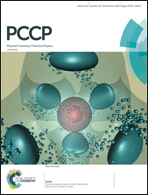Forcing the ‘lazy’ protons to work†
Abstract
The combination of cross-polarization (CP) with flip-back (FB) pulse has enabled in NMR the enhancement of 13C sensitivity and the decrease of the recycling delay at both moderate and fast magic-angle spinning (MAS) frequencies. However, only continuous-wave (CW) decoupling is presently compatible with FB-pulse (FB-CW), and depending on the CW radio-frequency (rf) field, either an insignificant sensitivity gain or an acquisition time-dependent gain and a low 13C resolution are obtained. In this study, we propose a new FB-pulse method in which radio frequency-driven recoupling (RFDR) is used as the 1H–13C decoupling scheme to overcome these drawbacks. The performances of FB-RFDR in terms of decoupling efficiency and sensitivity gain are tested on both natural abundance (NA) and uniformly 13C–15N labeled L-histidine·HCl·H2O (Hist) samples at a MAS frequency of νR = 70 kHz. The results show the superiority of RFDR over the CW decoupling with respect to these criteria. Importantly, they reveal that the sensitivity gain offered by FB-RFDR is nearly independent of the decoupling/acquisition duration. The application of FB-RFDR on NA-Hist and sucrose yields a sensitivity gain between 60 and 100% compared to conventional FB-CW and CPMAS-SPINAL experiments. Moreover, we compare the 13C sensitivities of NA-Hist obtained by our 1D FB-RFDR method and 2D 1H–{13C} double-CP acquisition. Both methods provide similar 13C sensitivity and are complementary. Indeed, the 2D method has the advantage of also providing the 1H–13C spatial proximities, but its sensitivity for quaternary carbons is limited; whereas our 1D FB-RFDR method is more independent of the type of carbon, and can provide a 13C 1D spectrum in a shorter experimental time. We also test the feasibility of FB-RFDR at a moderate frequency of νR = 20 kHz, but the experimental results demonstrate a poor resolution as well as a negligible sensitivity gain.



 Please wait while we load your content...
Please wait while we load your content...